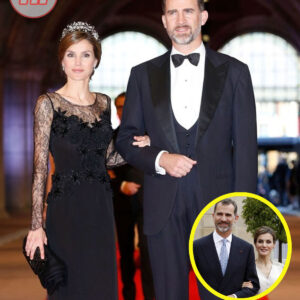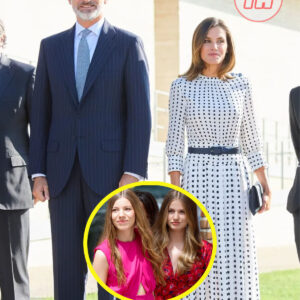Exploring the Dynamics: King Felipe’s Relationship With His Family
In the intricate tapestry of Spain’s royal family, the dynamics and relationships among its members often captivate public curiosity. At the heart of this interest lies King Felipe VI, whose position as the reigning monarch places him in a pivotal role within both his family and the nation.
This article delves into the hidden truths and complexities of King Felipe’s relationships with his family members, exploring the personal dynamics behind the public facade.
The Early Years and Family Background
King Felipe VI, born on January 30, 1968, ascended to the Spanish throne in June 2014 following the abdication of his father, King Juan Carlos I. His upbringing within the Spanish royal family was marked by tradition, duty, and a strong emphasis on public service.
As the eldest son of King Juan Carlos and Queen Sofía, Felipe grew up alongside his sisters, Infanta Elena and Infanta Cristina, in a household where royalty intertwined with the responsibilities of monarchy.

King Felipe’s Relationship with His Parents
Central to understanding King Felipe’s family dynamics is his relationship with his parents, King Juan Carlos I and Queen Sofía. King Juan Carlos, who abdicated in favor of his son amidst public scrutiny and health concerns, played a significant role in shaping Felipe’s preparation for kingship.
Their relationship, once perceived as close and supportive, has faced challenges in recent years amid controversies surrounding King Juan Carlos’s personal affairs and financial dealings.
Queen Sofía, known for her dedication to charitable causes and cultural pursuits, has maintained a steady presence in Felipe’s life and has been a supportive figure throughout his reign. Her role as a mother and grandmother continues to be an important aspect of Felipe’s familial connections.
Sibling Relationships: Infanta Elena and Infanta Cristina
King Felipe’s relationships with his sisters, Infanta Elena and Infanta Cristina, have evolved over time amidst personal challenges and public scrutiny. Infanta Elena, the elder of the two sisters, has been actively involved in royal duties and charitable work, often appearing alongside her brother at official events.
Their relationship is characterized by mutual respect and a shared commitment to representing the Spanish monarchy.

Infanta Cristina’s relationship with King Felipe has been more strained due to her involvement in legal controversies, including allegations of financial impropriety. In 2021, Infanta Cristina’s legal troubles concluded with her paying a fine and avoiding imprisonment, but the fallout from the scandal has undoubtedly impacted her relationship with her brother and the broader royal family.
Queen Letizia: A Modern Consort and Family Dynamics
Queen Letizia, formerly a journalist, brought a modern and independent spirit to the Spanish monarchy when she married King Felipe in 2004. Their relationship has been scrutinized by the media, with various reports highlighting both their public unity and occasional tensions.
Queen Letizia’s integration into the royal family and her role as a mother to Princess Leonor and Infanta Sofía have added new dimensions to King Felipe’s familial responsibilities.
The Next Generation: Princess Leonor and Infanta Sofía
Princess Leonor, born in 2005, and Infanta Sofía, born in 2007, represent the future of the Spanish royal family. King Felipe’s relationship with his daughters is characterized by a blend of paternal guidance and preparation for their eventual roles as heirs to the throne.
Their upbringing underlines the importance of balancing royal traditions with modern values, ensuring they are prepared for their future responsibilities within the monarchy.
Challenges and Triumphs: A Family in the Public Eye
The Spanish royal family, like many monarchies worldwide, faces challenges in maintaining public support and relevance in contemporary society. King Felipe’s efforts to modernize and streamline the monarchy have been met with both praise and criticism, reflecting broader debates about the role of royalty in democratic nations.
In conclusion, King Felipe VI’s relationships within his family are nuanced and multifaceted, shaped by tradition, duty, and personal dynamics. From his upbringing under King Juan Carlos and Queen Sofía to his own role as a husband, father, and monarch, King Felipe navigates the complexities of royal life with a blend of tradition and modernity.
As Spain continues to evolve, so too will the relationships and responsibilities of its royal family, ensuring they remain a symbol of unity and continuity in the nation’s history.
News
El coste de la monarquía española: Los reyes Letizia ganan una enorme cantidad de dinero cada año
La Zarzuela aplicó una subida del 3% respecto al presupuesto del 2022, tanto a las retribuciones de los Reyes como las del resto de funcionarios. El costo de la monarquía española: el Rey cobró más 250.000 euros y la reina…
La infanta Sofía y Leonor desencadenan un problema de celos que parte a Zarzuela en dos
No todos ven bien en Zarzuela que Leonor y Sofía hayan adquirido un fuerte protagonismo En los últimos meses, la familia real española ha sido escenario de un conflicto que ha sacudido las bases de Zarzuela. La revelación explosiva hecha por Jaime del Burgo ha intensificado la…
En qué se gasta el dinero la Familia Real: 4,1 millones en personal, 550.000 en teléfono y 60.000 en libros y prensa
Uno de los temas que más polémica genera en la política española es la cuestión monárquica. No solo por los escándalos asociados a la institución, sino también por el dinero que reciben anualmente. Como dispone el artículo 65.1 de la Constitución,…
CONOCE AL CADETE QUE CASI BESA A LA PRINCESA LEONOR
Conoce al Cadete que Casi Besa a la Princesa Leonor: Un Incidente que Conmocionó a España Recientemente, España ha sido testigo de un incidente que ha capturado la atención de medios y público por igual: un cadete de la Academia…
La princesa Leonor se une a Sofía para la foto ‘Pero por orden de la reina Letizia’
La Princesa Leonor se Une a Sofía para la Foto: “Pero por Orden de la Reina Letizia” La fotografía de la Princesa Leonor y la Infanta Sofía, capturada recientemente en un evento oficial, ha generado una avalancha de especulaciones y…
El ultra lujoso estilo de vida de la Princesa Leonor de España
El Ultra Lujoso Estilo de Vida de la Princesa Leonor de España: Un Vistazo a la Vida de la Heredera La Princesa Leonor de Asturias, hija mayor del Rey Felipe VI y la Reina Letizia, no solo es la heredera…
End of content
No more pages to load











